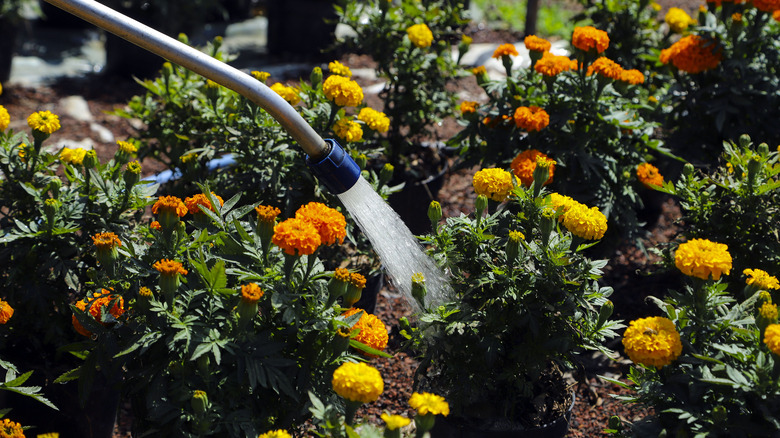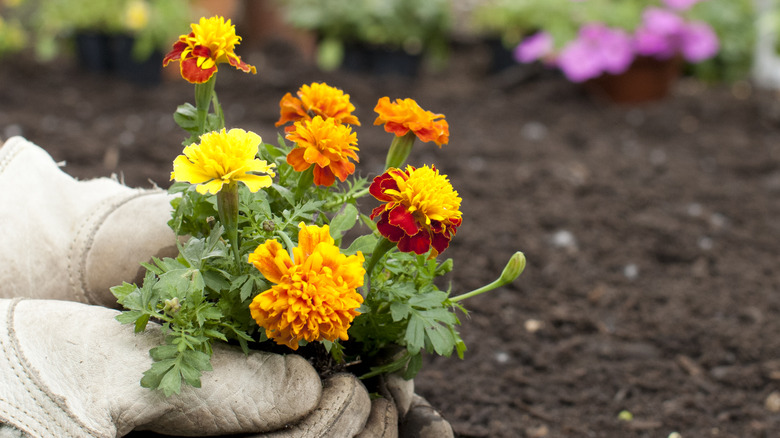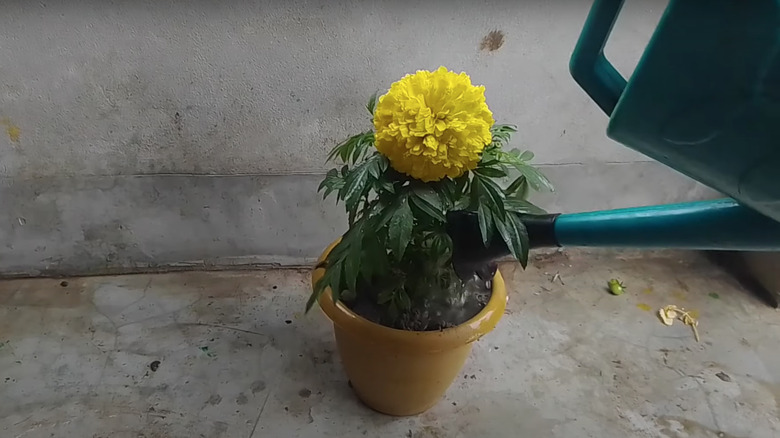The Best Method For Watering Marigolds
As a young or beginner gardener, you'd be hard-pressed to find a plant more adept at cultivating confidence than vibrant marigolds. Celebrated as one of the fastest and easiest flowering shrubs to grow, marigolds' hardy nature can cleverly convince anyone they have a green thumb. Unfortunately, the cheerful yellow and orange blooms aren't indestructible. If marigolds are robbed of adequate hydration, the entire plant will turn brown and die, as will, perhaps, the certitude that you possess the gift to garden. To avoid this tragic turn in self-assurance, simply employ the best method for watering marigolds, which combines proper timing, amount, and placement.
Just looking at the fluffy layers of ruffled petals that form marigolds' pom-pom flowerheads is enough to bring unlimited joy to a homeowner. But, let's be honest, the fact that they're so low-maintenance is a bonus not lost on gardeners regardless of skill level. Whether you're growing the gold blossoms in a container, vegetable garden, or along the perimeter of your yard as ornamental landscaping, their unfussy disposition is just one of the many benefits of planting marigolds. Ensuring they continue to thrive requires little more than access to full sunshine and regular watering. But don't be lulled into complacency when it comes to this uncomplicated upkeep. Given the significance of accurate irrigation, you'll want to make sure that when you do water marigolds, you're doing so correctly.
Timing and quantity are key
How hard can it be to water a plant? Especially ones that are drought-resistant and heat-tolerant like marigolds. The answer isn't as straightforward as you may think. Watering may seem like a simple task, but its success requires a combination of art and science. For example, young marigolds need to be watered more frequently than established ones to properly moisten the soil and initiate a healthy root system.
When crafting a watering schedule for recently planted marigolds, aim to hydrate once every two days to keep the soil slightly saturated. Continue this routine for one to two weeks, then taper to once every two weeks. The exact frequency will depend on how hot it is. In periods of intense heat, water marigolds every other day, paying close attention to the level of moisture in the plant's soil. If you notice dryness in the top one-half inch of soil, it's time to give your marigolds a drink. To maximize moisture, time the pour for mornings and evenings when the temperatures are cooler, thereby slowing the rate of evaporation.
Generally, marigolds need between 1.5 to 2 inches of water per week. Err on the higher side for potted marigolds. Planted versions won't need the full 2 inches as natural groundwater acts as a supplemental source of hydration. Bottom line: common sense rules. If it's been raining for days, water less. Conversely, if the weather has been extremely dry, water more, but don't exceed 3 inches per week.
Water at the root
Whether your marigolds are growing in a pot, container, or in the ground, avoid watering them from above; rather, aim for the roots. Since marigolds obtain hydration through the soil, giving them a good soak at the base will ensure water is absorbed by the roots and then travel through the stems to the leaves. What's more, dousing marigolds from above can cause water to cascade down, covering leaves and flowers. In some cases, allowing a layer of water to coat foliage can lead to harmful fungal diseases.
To avoid damaging marigolds in the watering process, use a soaker hose for planted blooms and a watering can for potted varieties. In either case, it's imperative to aim the device toward the base of the plant and drench the soil. Just don't go overboard. Ideally, the soil should be moist, not waterlogged. Overwatering marigolds can lead to root rot, which could eventually kill the entire plant. You can prevent this by listening to your marigolds. They will communicate when they've had too much to drink via drooping blooms, yellowing leaves, and growing fungus on lower stems. When in doubt, allow the soil to dry out between each watering period.


